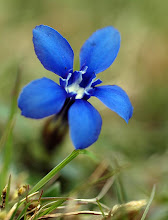These beautiful objects are potato starch grains. Slice a potato, shake the slices in a glass of water and the water will become milky due to the release of starch from the broken cells. Put a drop of this milky water on a microscope slide, viewed it under a microscope using polarised light and this is what you see. The starch itself is colourless and translucent - polarised light is responsible to generating the colours and the distinctive ‘Maltese Cross’ pattern in the grains. Starch grains are polymers of glucose molecules and are the means by which plants store energy for future use. It is breakdown of starch in stems, roots, rhizomes, buds and leaves that is - as this very moment – releasing the energy that plants are using for new spring growth, before photosynthesis in their leaves takes over the job. It’s also starch that provides most of the calorie intake for almost all of the human population on the planet.
The form and size of starch grains varies depending on plant species and in potato they are relatively large – up to one tenth of a millimetre in diameter. Very fine starch, such as that produced in the tubers of cuckoo pint was used to stiffen cloth and was used by the Eliabethan courtiers to stiffen their magnificent ruffs.















